Strategic Analysis of Tesco: Recovery Plan and Recommendations
VerifiedAdded on 2023/04/19
|18
|4446
|72
Report
AI Summary
This report provides a comprehensive strategic analysis of Tesco's recovery plan, addressing the major issues faced by the company in the competitive UK retail industry. The report begins with an introduction to Tesco, its market position, and the challenges it faces, particularly increased competition. It then proceeds to analyze Tesco's external environment using a PESTLE analysis, examining political, economic, social, technological, environmental, and legal factors. The internal environment is assessed using a SWOT analysis, identifying strengths, weaknesses, opportunities, and threats. The industry is analyzed using Porter's Five Forces framework to understand competitive dynamics. Based on these analyses, the report offers recommendations for Tesco's recovery, focusing on strategies to improve its competitive position, profitability, and overall performance. The report concludes with a summary of the key findings and recommendations, offering insights into Tesco's strategic direction.
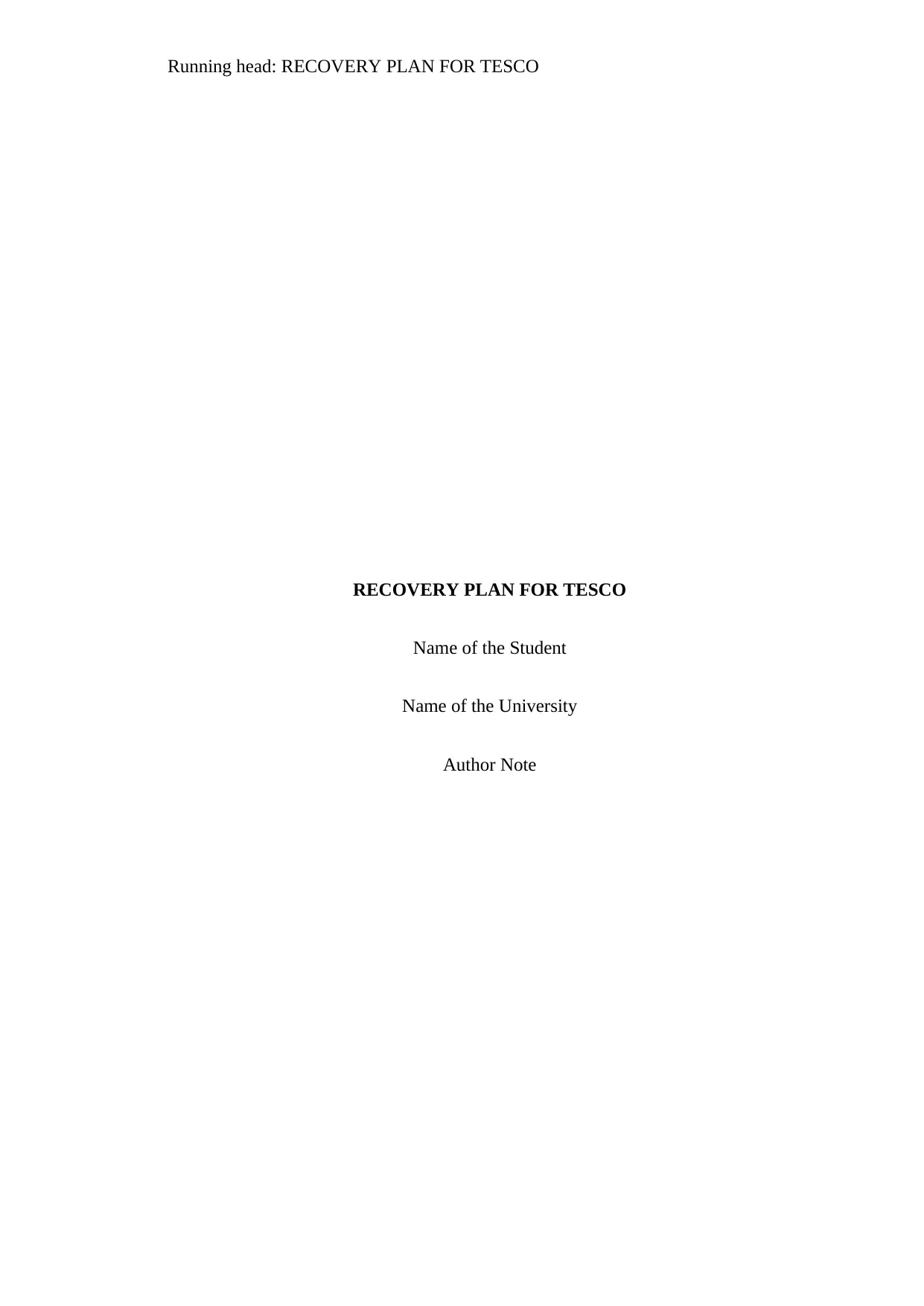
Running head: RECOVERY PLAN FOR TESCO
RECOVERY PLAN FOR TESCO
Name of the Student
Name of the University
Author Note
RECOVERY PLAN FOR TESCO
Name of the Student
Name of the University
Author Note
Paraphrase This Document
Need a fresh take? Get an instant paraphrase of this document with our AI Paraphraser
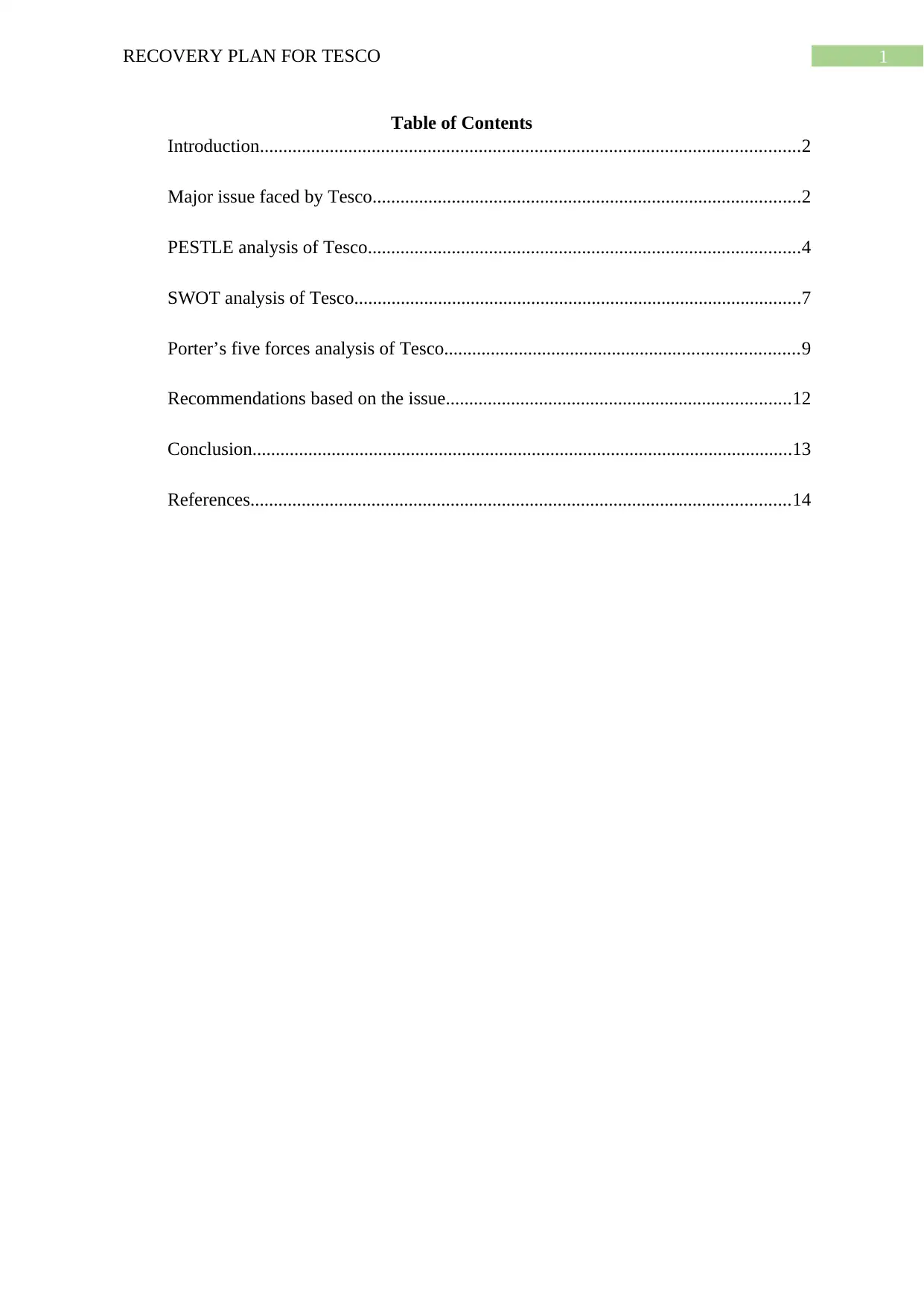
1RECOVERY PLAN FOR TESCO
Table of Contents
Introduction....................................................................................................................2
Major issue faced by Tesco............................................................................................2
PESTLE analysis of Tesco.............................................................................................4
SWOT analysis of Tesco................................................................................................7
Porter’s five forces analysis of Tesco............................................................................9
Recommendations based on the issue..........................................................................12
Conclusion....................................................................................................................13
References....................................................................................................................14
Table of Contents
Introduction....................................................................................................................2
Major issue faced by Tesco............................................................................................2
PESTLE analysis of Tesco.............................................................................................4
SWOT analysis of Tesco................................................................................................7
Porter’s five forces analysis of Tesco............................................................................9
Recommendations based on the issue..........................................................................12
Conclusion....................................................................................................................13
References....................................................................................................................14
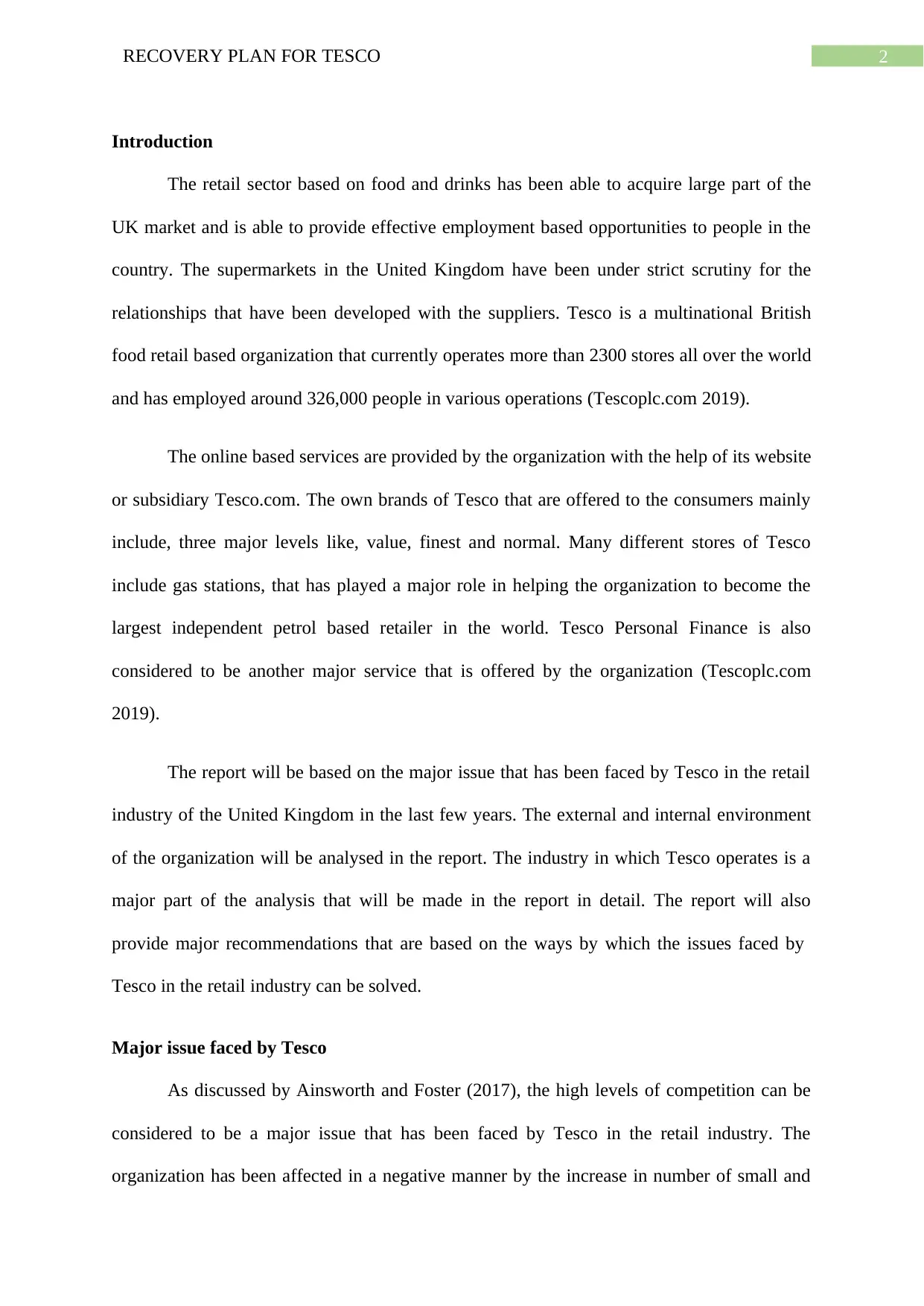
2RECOVERY PLAN FOR TESCO
Introduction
The retail sector based on food and drinks has been able to acquire large part of the
UK market and is able to provide effective employment based opportunities to people in the
country. The supermarkets in the United Kingdom have been under strict scrutiny for the
relationships that have been developed with the suppliers. Tesco is a multinational British
food retail based organization that currently operates more than 2300 stores all over the world
and has employed around 326,000 people in various operations (Tescoplc.com 2019).
The online based services are provided by the organization with the help of its website
or subsidiary Tesco.com. The own brands of Tesco that are offered to the consumers mainly
include, three major levels like, value, finest and normal. Many different stores of Tesco
include gas stations, that has played a major role in helping the organization to become the
largest independent petrol based retailer in the world. Tesco Personal Finance is also
considered to be another major service that is offered by the organization (Tescoplc.com
2019).
The report will be based on the major issue that has been faced by Tesco in the retail
industry of the United Kingdom in the last few years. The external and internal environment
of the organization will be analysed in the report. The industry in which Tesco operates is a
major part of the analysis that will be made in the report in detail. The report will also
provide major recommendations that are based on the ways by which the issues faced by
Tesco in the retail industry can be solved.
Major issue faced by Tesco
As discussed by Ainsworth and Foster (2017), the high levels of competition can be
considered to be a major issue that has been faced by Tesco in the retail industry. The
organization has been affected in a negative manner by the increase in number of small and
Introduction
The retail sector based on food and drinks has been able to acquire large part of the
UK market and is able to provide effective employment based opportunities to people in the
country. The supermarkets in the United Kingdom have been under strict scrutiny for the
relationships that have been developed with the suppliers. Tesco is a multinational British
food retail based organization that currently operates more than 2300 stores all over the world
and has employed around 326,000 people in various operations (Tescoplc.com 2019).
The online based services are provided by the organization with the help of its website
or subsidiary Tesco.com. The own brands of Tesco that are offered to the consumers mainly
include, three major levels like, value, finest and normal. Many different stores of Tesco
include gas stations, that has played a major role in helping the organization to become the
largest independent petrol based retailer in the world. Tesco Personal Finance is also
considered to be another major service that is offered by the organization (Tescoplc.com
2019).
The report will be based on the major issue that has been faced by Tesco in the retail
industry of the United Kingdom in the last few years. The external and internal environment
of the organization will be analysed in the report. The industry in which Tesco operates is a
major part of the analysis that will be made in the report in detail. The report will also
provide major recommendations that are based on the ways by which the issues faced by
Tesco in the retail industry can be solved.
Major issue faced by Tesco
As discussed by Ainsworth and Foster (2017), the high levels of competition can be
considered to be a major issue that has been faced by Tesco in the retail industry. The
organization has been affected in a negative manner by the increase in number of small and
⊘ This is a preview!⊘
Do you want full access?
Subscribe today to unlock all pages.

Trusted by 1+ million students worldwide
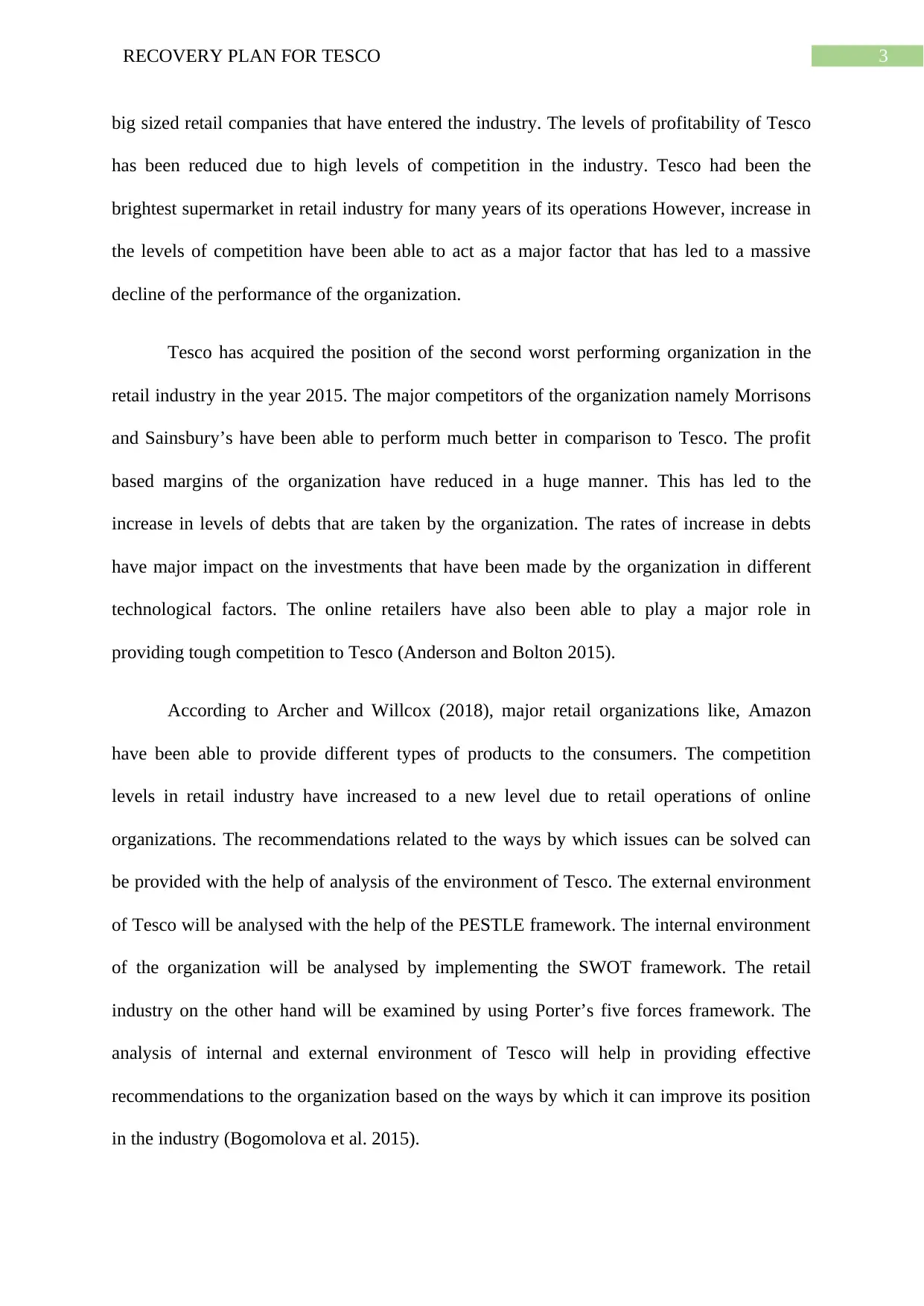
3RECOVERY PLAN FOR TESCO
big sized retail companies that have entered the industry. The levels of profitability of Tesco
has been reduced due to high levels of competition in the industry. Tesco had been the
brightest supermarket in retail industry for many years of its operations However, increase in
the levels of competition have been able to act as a major factor that has led to a massive
decline of the performance of the organization.
Tesco has acquired the position of the second worst performing organization in the
retail industry in the year 2015. The major competitors of the organization namely Morrisons
and Sainsbury’s have been able to perform much better in comparison to Tesco. The profit
based margins of the organization have reduced in a huge manner. This has led to the
increase in levels of debts that are taken by the organization. The rates of increase in debts
have major impact on the investments that have been made by the organization in different
technological factors. The online retailers have also been able to play a major role in
providing tough competition to Tesco (Anderson and Bolton 2015).
According to Archer and Willcox (2018), major retail organizations like, Amazon
have been able to provide different types of products to the consumers. The competition
levels in retail industry have increased to a new level due to retail operations of online
organizations. The recommendations related to the ways by which issues can be solved can
be provided with the help of analysis of the environment of Tesco. The external environment
of Tesco will be analysed with the help of the PESTLE framework. The internal environment
of the organization will be analysed by implementing the SWOT framework. The retail
industry on the other hand will be examined by using Porter’s five forces framework. The
analysis of internal and external environment of Tesco will help in providing effective
recommendations to the organization based on the ways by which it can improve its position
in the industry (Bogomolova et al. 2015).
big sized retail companies that have entered the industry. The levels of profitability of Tesco
has been reduced due to high levels of competition in the industry. Tesco had been the
brightest supermarket in retail industry for many years of its operations However, increase in
the levels of competition have been able to act as a major factor that has led to a massive
decline of the performance of the organization.
Tesco has acquired the position of the second worst performing organization in the
retail industry in the year 2015. The major competitors of the organization namely Morrisons
and Sainsbury’s have been able to perform much better in comparison to Tesco. The profit
based margins of the organization have reduced in a huge manner. This has led to the
increase in levels of debts that are taken by the organization. The rates of increase in debts
have major impact on the investments that have been made by the organization in different
technological factors. The online retailers have also been able to play a major role in
providing tough competition to Tesco (Anderson and Bolton 2015).
According to Archer and Willcox (2018), major retail organizations like, Amazon
have been able to provide different types of products to the consumers. The competition
levels in retail industry have increased to a new level due to retail operations of online
organizations. The recommendations related to the ways by which issues can be solved can
be provided with the help of analysis of the environment of Tesco. The external environment
of Tesco will be analysed with the help of the PESTLE framework. The internal environment
of the organization will be analysed by implementing the SWOT framework. The retail
industry on the other hand will be examined by using Porter’s five forces framework. The
analysis of internal and external environment of Tesco will help in providing effective
recommendations to the organization based on the ways by which it can improve its position
in the industry (Bogomolova et al. 2015).
Paraphrase This Document
Need a fresh take? Get an instant paraphrase of this document with our AI Paraphraser
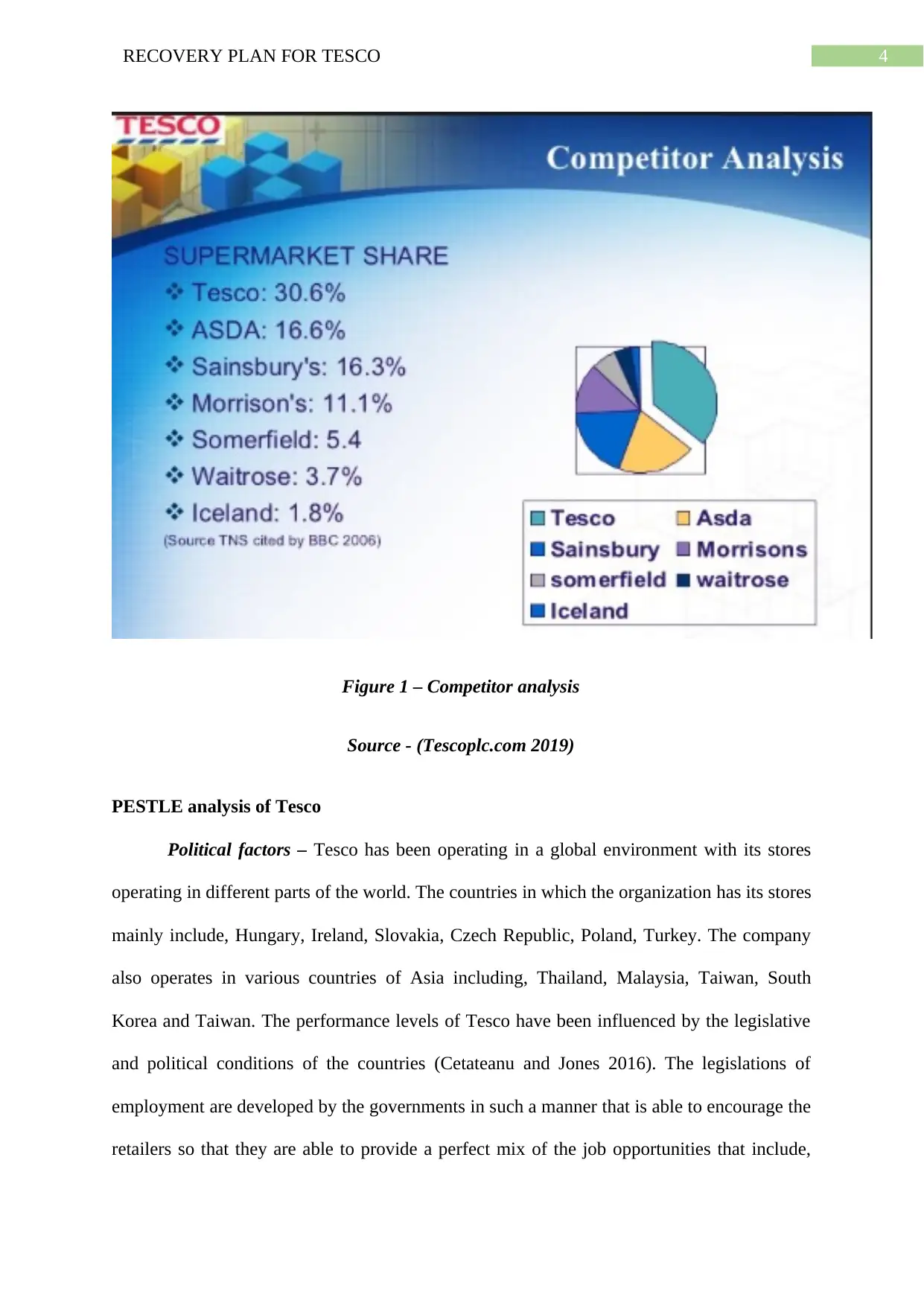
4RECOVERY PLAN FOR TESCO
Figure 1 – Competitor analysis
Source - (Tescoplc.com 2019)
PESTLE analysis of Tesco
Political factors – Tesco has been operating in a global environment with its stores
operating in different parts of the world. The countries in which the organization has its stores
mainly include, Hungary, Ireland, Slovakia, Czech Republic, Poland, Turkey. The company
also operates in various countries of Asia including, Thailand, Malaysia, Taiwan, South
Korea and Taiwan. The performance levels of Tesco have been influenced by the legislative
and political conditions of the countries (Cetateanu and Jones 2016). The legislations of
employment are developed by the governments in such a manner that is able to encourage the
retailers so that they are able to provide a perfect mix of the job opportunities that include,
Figure 1 – Competitor analysis
Source - (Tescoplc.com 2019)
PESTLE analysis of Tesco
Political factors – Tesco has been operating in a global environment with its stores
operating in different parts of the world. The countries in which the organization has its stores
mainly include, Hungary, Ireland, Slovakia, Czech Republic, Poland, Turkey. The company
also operates in various countries of Asia including, Thailand, Malaysia, Taiwan, South
Korea and Taiwan. The performance levels of Tesco have been influenced by the legislative
and political conditions of the countries (Cetateanu and Jones 2016). The legislations of
employment are developed by the governments in such a manner that is able to encourage the
retailers so that they are able to provide a perfect mix of the job opportunities that include,
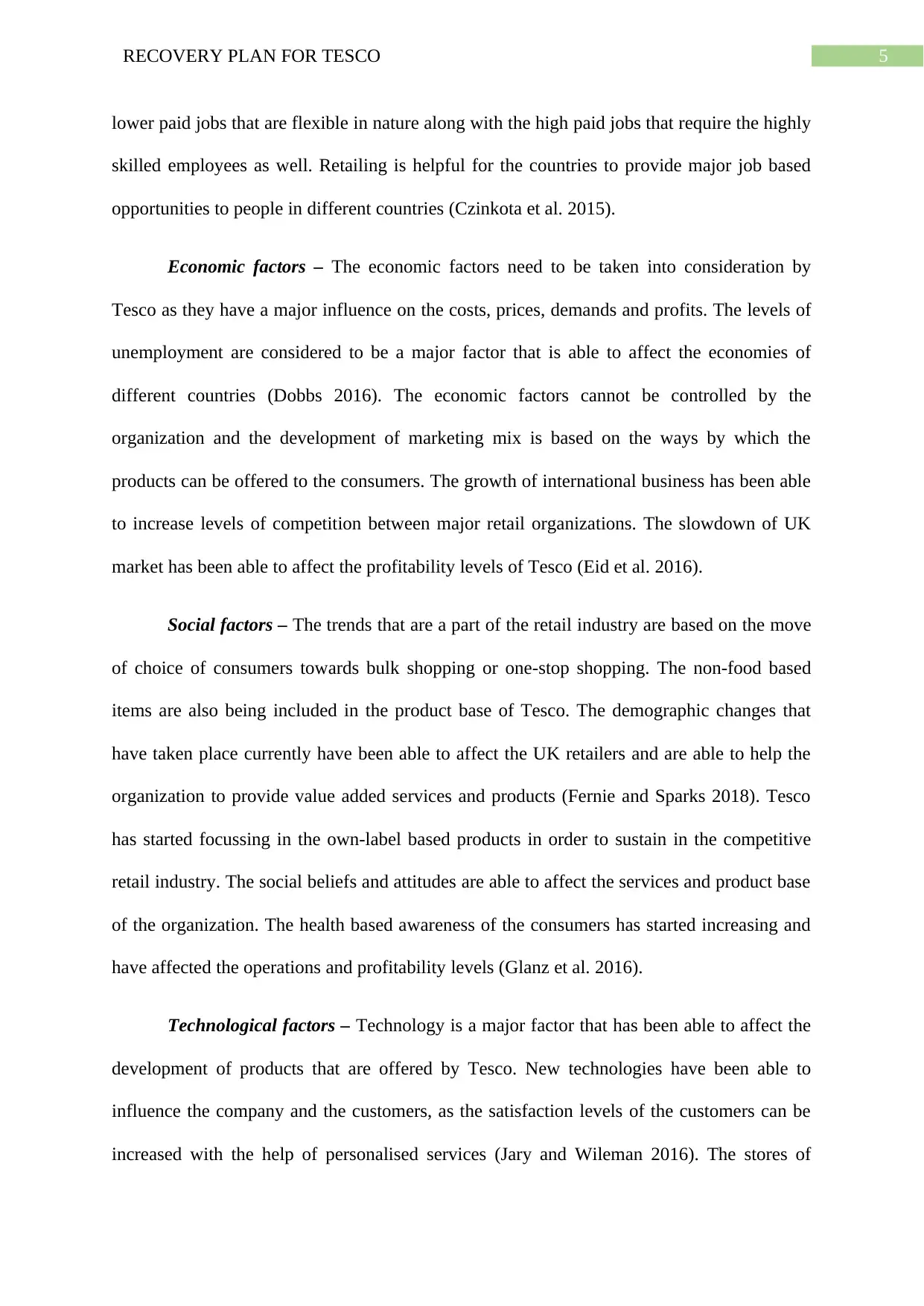
5RECOVERY PLAN FOR TESCO
lower paid jobs that are flexible in nature along with the high paid jobs that require the highly
skilled employees as well. Retailing is helpful for the countries to provide major job based
opportunities to people in different countries (Czinkota et al. 2015).
Economic factors – The economic factors need to be taken into consideration by
Tesco as they have a major influence on the costs, prices, demands and profits. The levels of
unemployment are considered to be a major factor that is able to affect the economies of
different countries (Dobbs 2016). The economic factors cannot be controlled by the
organization and the development of marketing mix is based on the ways by which the
products can be offered to the consumers. The growth of international business has been able
to increase levels of competition between major retail organizations. The slowdown of UK
market has been able to affect the profitability levels of Tesco (Eid et al. 2016).
Social factors – The trends that are a part of the retail industry are based on the move
of choice of consumers towards bulk shopping or one-stop shopping. The non-food based
items are also being included in the product base of Tesco. The demographic changes that
have taken place currently have been able to affect the UK retailers and are able to help the
organization to provide value added services and products (Fernie and Sparks 2018). Tesco
has started focussing in the own-label based products in order to sustain in the competitive
retail industry. The social beliefs and attitudes are able to affect the services and product base
of the organization. The health based awareness of the consumers has started increasing and
have affected the operations and profitability levels (Glanz et al. 2016).
Technological factors – Technology is a major factor that has been able to affect the
development of products that are offered by Tesco. New technologies have been able to
influence the company and the customers, as the satisfaction levels of the customers can be
increased with the help of personalised services (Jary and Wileman 2016). The stores of
lower paid jobs that are flexible in nature along with the high paid jobs that require the highly
skilled employees as well. Retailing is helpful for the countries to provide major job based
opportunities to people in different countries (Czinkota et al. 2015).
Economic factors – The economic factors need to be taken into consideration by
Tesco as they have a major influence on the costs, prices, demands and profits. The levels of
unemployment are considered to be a major factor that is able to affect the economies of
different countries (Dobbs 2016). The economic factors cannot be controlled by the
organization and the development of marketing mix is based on the ways by which the
products can be offered to the consumers. The growth of international business has been able
to increase levels of competition between major retail organizations. The slowdown of UK
market has been able to affect the profitability levels of Tesco (Eid et al. 2016).
Social factors – The trends that are a part of the retail industry are based on the move
of choice of consumers towards bulk shopping or one-stop shopping. The non-food based
items are also being included in the product base of Tesco. The demographic changes that
have taken place currently have been able to affect the UK retailers and are able to help the
organization to provide value added services and products (Fernie and Sparks 2018). Tesco
has started focussing in the own-label based products in order to sustain in the competitive
retail industry. The social beliefs and attitudes are able to affect the services and product base
of the organization. The health based awareness of the consumers has started increasing and
have affected the operations and profitability levels (Glanz et al. 2016).
Technological factors – Technology is a major factor that has been able to affect the
development of products that are offered by Tesco. New technologies have been able to
influence the company and the customers, as the satisfaction levels of the customers can be
increased with the help of personalised services (Jary and Wileman 2016). The stores of
⊘ This is a preview!⊘
Do you want full access?
Subscribe today to unlock all pages.

Trusted by 1+ million students worldwide
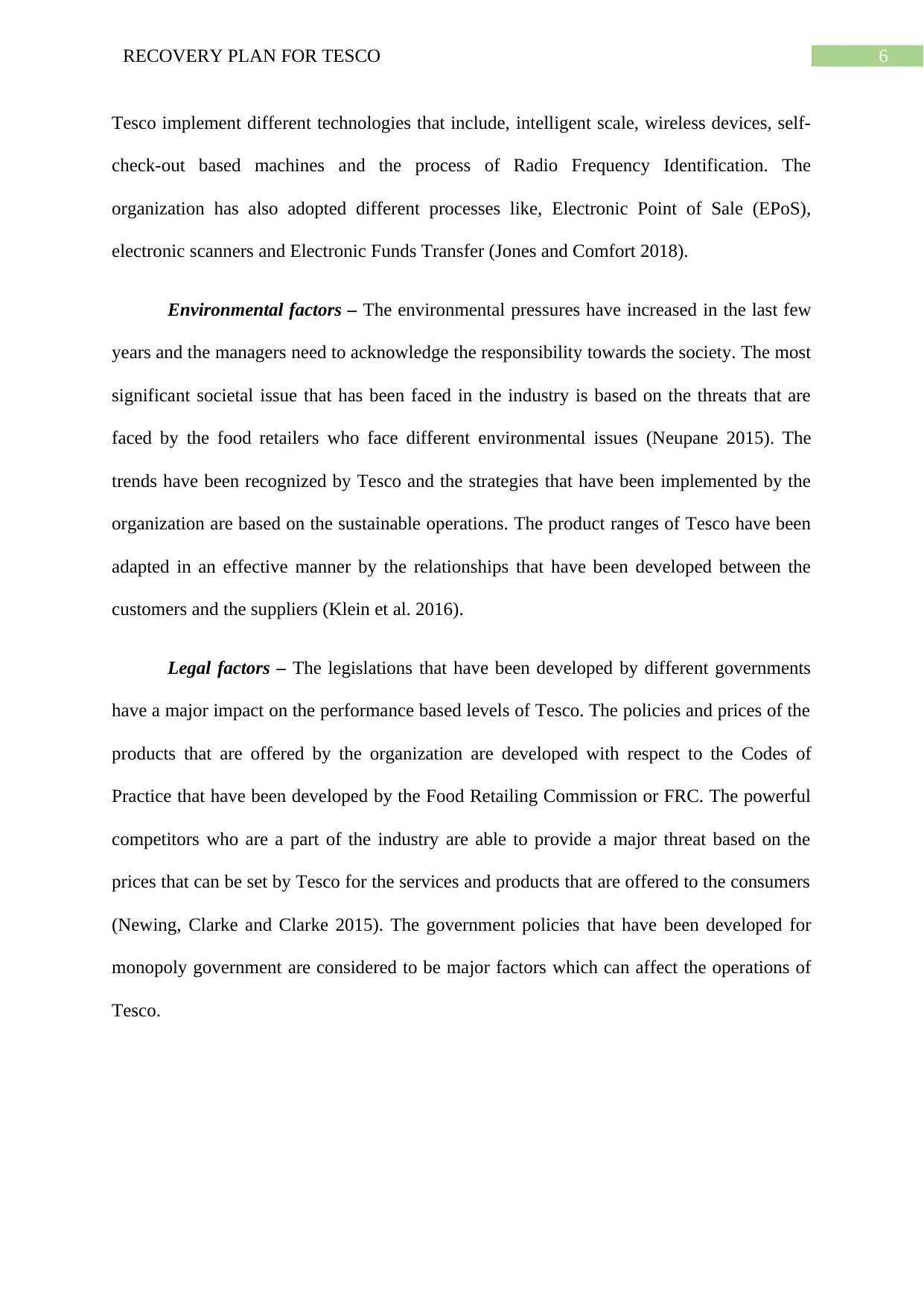
6RECOVERY PLAN FOR TESCO
Tesco implement different technologies that include, intelligent scale, wireless devices, self-
check-out based machines and the process of Radio Frequency Identification. The
organization has also adopted different processes like, Electronic Point of Sale (EPoS),
electronic scanners and Electronic Funds Transfer (Jones and Comfort 2018).
Environmental factors – The environmental pressures have increased in the last few
years and the managers need to acknowledge the responsibility towards the society. The most
significant societal issue that has been faced in the industry is based on the threats that are
faced by the food retailers who face different environmental issues (Neupane 2015). The
trends have been recognized by Tesco and the strategies that have been implemented by the
organization are based on the sustainable operations. The product ranges of Tesco have been
adapted in an effective manner by the relationships that have been developed between the
customers and the suppliers (Klein et al. 2016).
Legal factors – The legislations that have been developed by different governments
have a major impact on the performance based levels of Tesco. The policies and prices of the
products that are offered by the organization are developed with respect to the Codes of
Practice that have been developed by the Food Retailing Commission or FRC. The powerful
competitors who are a part of the industry are able to provide a major threat based on the
prices that can be set by Tesco for the services and products that are offered to the consumers
(Newing, Clarke and Clarke 2015). The government policies that have been developed for
monopoly government are considered to be major factors which can affect the operations of
Tesco.
Tesco implement different technologies that include, intelligent scale, wireless devices, self-
check-out based machines and the process of Radio Frequency Identification. The
organization has also adopted different processes like, Electronic Point of Sale (EPoS),
electronic scanners and Electronic Funds Transfer (Jones and Comfort 2018).
Environmental factors – The environmental pressures have increased in the last few
years and the managers need to acknowledge the responsibility towards the society. The most
significant societal issue that has been faced in the industry is based on the threats that are
faced by the food retailers who face different environmental issues (Neupane 2015). The
trends have been recognized by Tesco and the strategies that have been implemented by the
organization are based on the sustainable operations. The product ranges of Tesco have been
adapted in an effective manner by the relationships that have been developed between the
customers and the suppliers (Klein et al. 2016).
Legal factors – The legislations that have been developed by different governments
have a major impact on the performance based levels of Tesco. The policies and prices of the
products that are offered by the organization are developed with respect to the Codes of
Practice that have been developed by the Food Retailing Commission or FRC. The powerful
competitors who are a part of the industry are able to provide a major threat based on the
prices that can be set by Tesco for the services and products that are offered to the consumers
(Newing, Clarke and Clarke 2015). The government policies that have been developed for
monopoly government are considered to be major factors which can affect the operations of
Tesco.
Paraphrase This Document
Need a fresh take? Get an instant paraphrase of this document with our AI Paraphraser
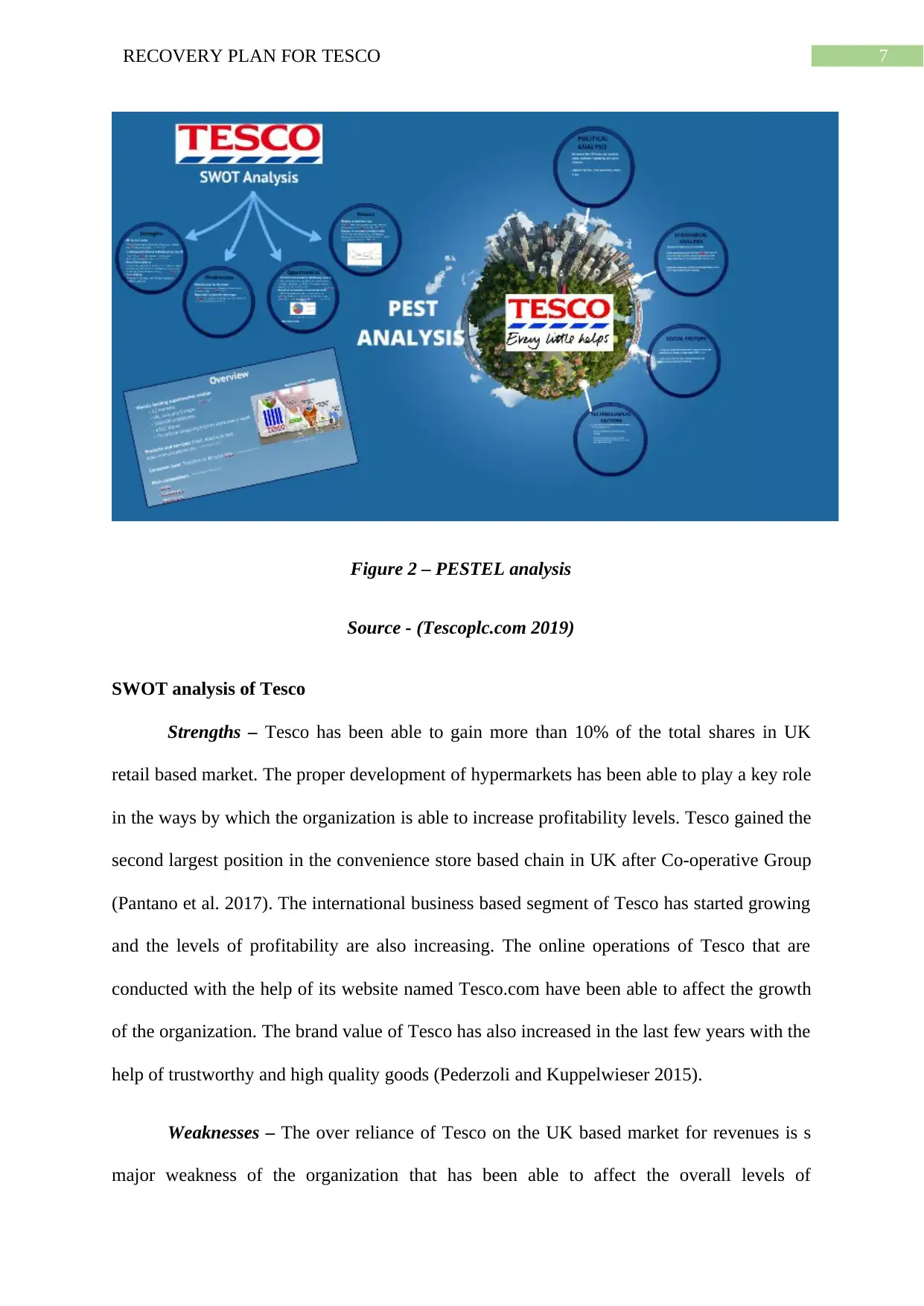
7RECOVERY PLAN FOR TESCO
Figure 2 – PESTEL analysis
Source - (Tescoplc.com 2019)
SWOT analysis of Tesco
Strengths – Tesco has been able to gain more than 10% of the total shares in UK
retail based market. The proper development of hypermarkets has been able to play a key role
in the ways by which the organization is able to increase profitability levels. Tesco gained the
second largest position in the convenience store based chain in UK after Co-operative Group
(Pantano et al. 2017). The international business based segment of Tesco has started growing
and the levels of profitability are also increasing. The online operations of Tesco that are
conducted with the help of its website named Tesco.com have been able to affect the growth
of the organization. The brand value of Tesco has also increased in the last few years with the
help of trustworthy and high quality goods (Pederzoli and Kuppelwieser 2015).
Weaknesses – The over reliance of Tesco on the UK based market for revenues is s
major weakness of the organization that has been able to affect the overall levels of
Figure 2 – PESTEL analysis
Source - (Tescoplc.com 2019)
SWOT analysis of Tesco
Strengths – Tesco has been able to gain more than 10% of the total shares in UK
retail based market. The proper development of hypermarkets has been able to play a key role
in the ways by which the organization is able to increase profitability levels. Tesco gained the
second largest position in the convenience store based chain in UK after Co-operative Group
(Pantano et al. 2017). The international business based segment of Tesco has started growing
and the levels of profitability are also increasing. The online operations of Tesco that are
conducted with the help of its website named Tesco.com have been able to affect the growth
of the organization. The brand value of Tesco has also increased in the last few years with the
help of trustworthy and high quality goods (Pederzoli and Kuppelwieser 2015).
Weaknesses – The over reliance of Tesco on the UK based market for revenues is s
major weakness of the organization that has been able to affect the overall levels of
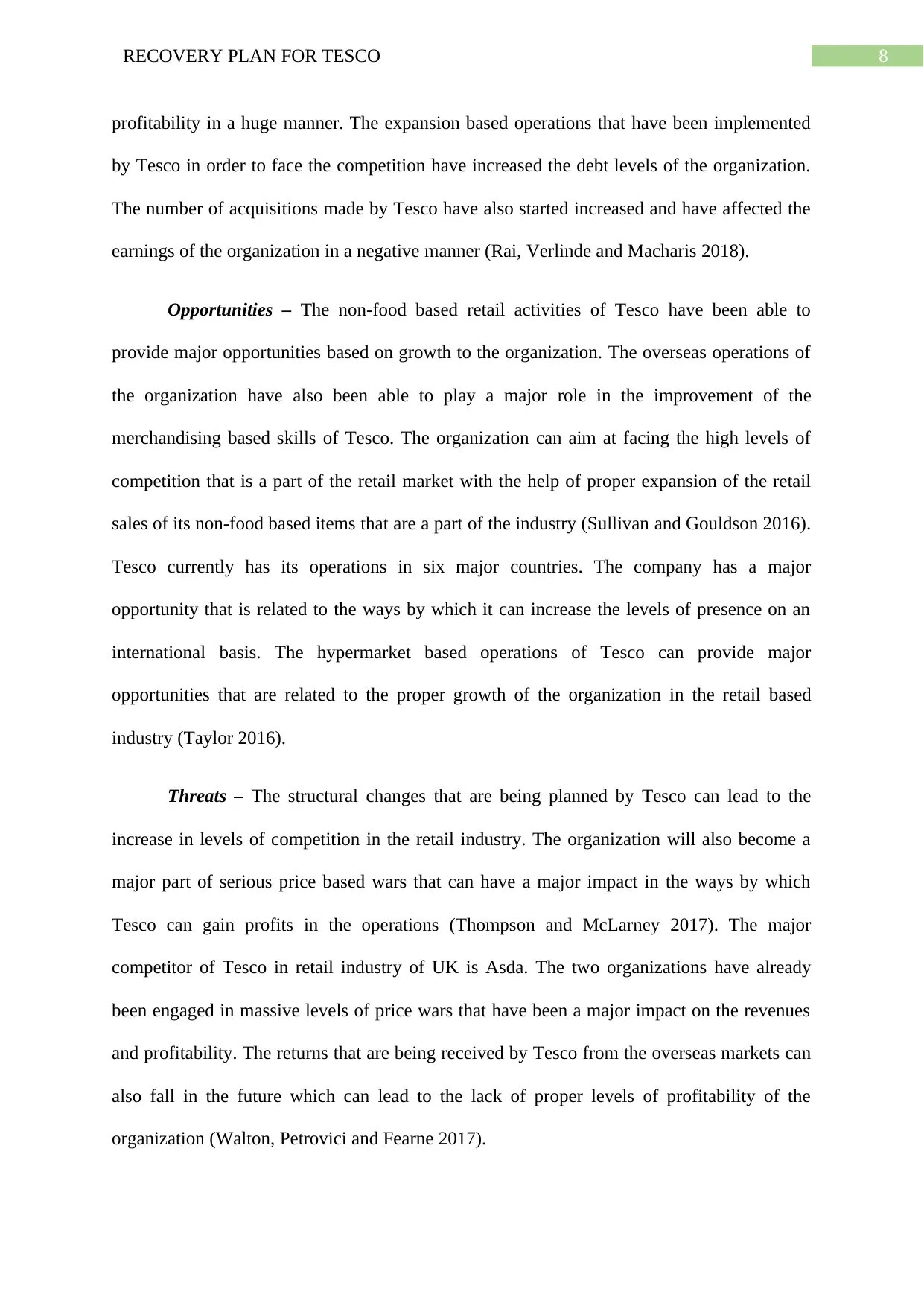
8RECOVERY PLAN FOR TESCO
profitability in a huge manner. The expansion based operations that have been implemented
by Tesco in order to face the competition have increased the debt levels of the organization.
The number of acquisitions made by Tesco have also started increased and have affected the
earnings of the organization in a negative manner (Rai, Verlinde and Macharis 2018).
Opportunities – The non-food based retail activities of Tesco have been able to
provide major opportunities based on growth to the organization. The overseas operations of
the organization have also been able to play a major role in the improvement of the
merchandising based skills of Tesco. The organization can aim at facing the high levels of
competition that is a part of the retail market with the help of proper expansion of the retail
sales of its non-food based items that are a part of the industry (Sullivan and Gouldson 2016).
Tesco currently has its operations in six major countries. The company has a major
opportunity that is related to the ways by which it can increase the levels of presence on an
international basis. The hypermarket based operations of Tesco can provide major
opportunities that are related to the proper growth of the organization in the retail based
industry (Taylor 2016).
Threats – The structural changes that are being planned by Tesco can lead to the
increase in levels of competition in the retail industry. The organization will also become a
major part of serious price based wars that can have a major impact in the ways by which
Tesco can gain profits in the operations (Thompson and McLarney 2017). The major
competitor of Tesco in retail industry of UK is Asda. The two organizations have already
been engaged in massive levels of price wars that have been a major impact on the revenues
and profitability. The returns that are being received by Tesco from the overseas markets can
also fall in the future which can lead to the lack of proper levels of profitability of the
organization (Walton, Petrovici and Fearne 2017).
profitability in a huge manner. The expansion based operations that have been implemented
by Tesco in order to face the competition have increased the debt levels of the organization.
The number of acquisitions made by Tesco have also started increased and have affected the
earnings of the organization in a negative manner (Rai, Verlinde and Macharis 2018).
Opportunities – The non-food based retail activities of Tesco have been able to
provide major opportunities based on growth to the organization. The overseas operations of
the organization have also been able to play a major role in the improvement of the
merchandising based skills of Tesco. The organization can aim at facing the high levels of
competition that is a part of the retail market with the help of proper expansion of the retail
sales of its non-food based items that are a part of the industry (Sullivan and Gouldson 2016).
Tesco currently has its operations in six major countries. The company has a major
opportunity that is related to the ways by which it can increase the levels of presence on an
international basis. The hypermarket based operations of Tesco can provide major
opportunities that are related to the proper growth of the organization in the retail based
industry (Taylor 2016).
Threats – The structural changes that are being planned by Tesco can lead to the
increase in levels of competition in the retail industry. The organization will also become a
major part of serious price based wars that can have a major impact in the ways by which
Tesco can gain profits in the operations (Thompson and McLarney 2017). The major
competitor of Tesco in retail industry of UK is Asda. The two organizations have already
been engaged in massive levels of price wars that have been a major impact on the revenues
and profitability. The returns that are being received by Tesco from the overseas markets can
also fall in the future which can lead to the lack of proper levels of profitability of the
organization (Walton, Petrovici and Fearne 2017).
⊘ This is a preview!⊘
Do you want full access?
Subscribe today to unlock all pages.

Trusted by 1+ million students worldwide
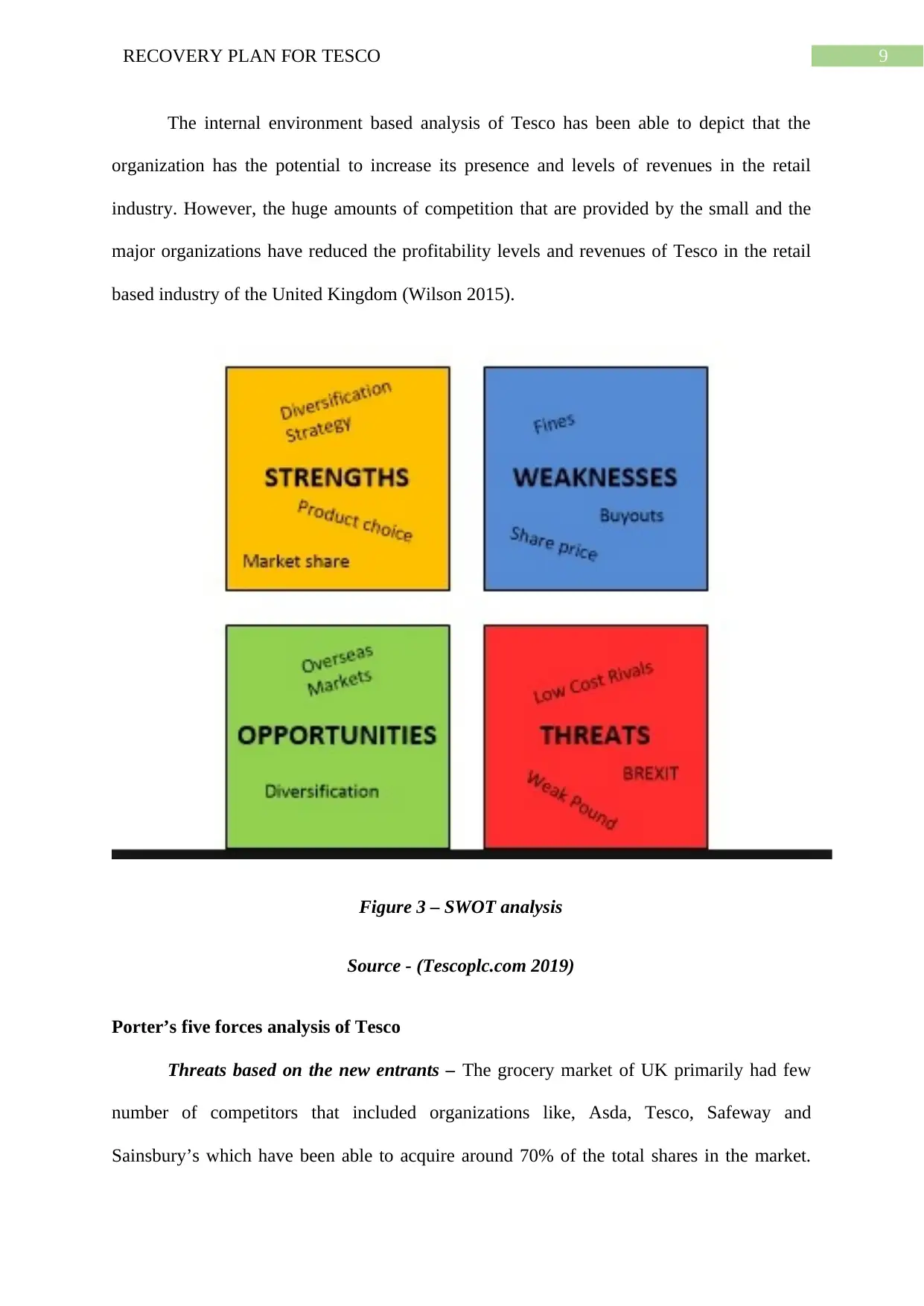
9RECOVERY PLAN FOR TESCO
The internal environment based analysis of Tesco has been able to depict that the
organization has the potential to increase its presence and levels of revenues in the retail
industry. However, the huge amounts of competition that are provided by the small and the
major organizations have reduced the profitability levels and revenues of Tesco in the retail
based industry of the United Kingdom (Wilson 2015).
Figure 3 – SWOT analysis
Source - (Tescoplc.com 2019)
Porter’s five forces analysis of Tesco
Threats based on the new entrants – The grocery market of UK primarily had few
number of competitors that included organizations like, Asda, Tesco, Safeway and
Sainsbury’s which have been able to acquire around 70% of the total shares in the market.
The internal environment based analysis of Tesco has been able to depict that the
organization has the potential to increase its presence and levels of revenues in the retail
industry. However, the huge amounts of competition that are provided by the small and the
major organizations have reduced the profitability levels and revenues of Tesco in the retail
based industry of the United Kingdom (Wilson 2015).
Figure 3 – SWOT analysis
Source - (Tescoplc.com 2019)
Porter’s five forces analysis of Tesco
Threats based on the new entrants – The grocery market of UK primarily had few
number of competitors that included organizations like, Asda, Tesco, Safeway and
Sainsbury’s which have been able to acquire around 70% of the total shares in the market.
Paraphrase This Document
Need a fresh take? Get an instant paraphrase of this document with our AI Paraphraser
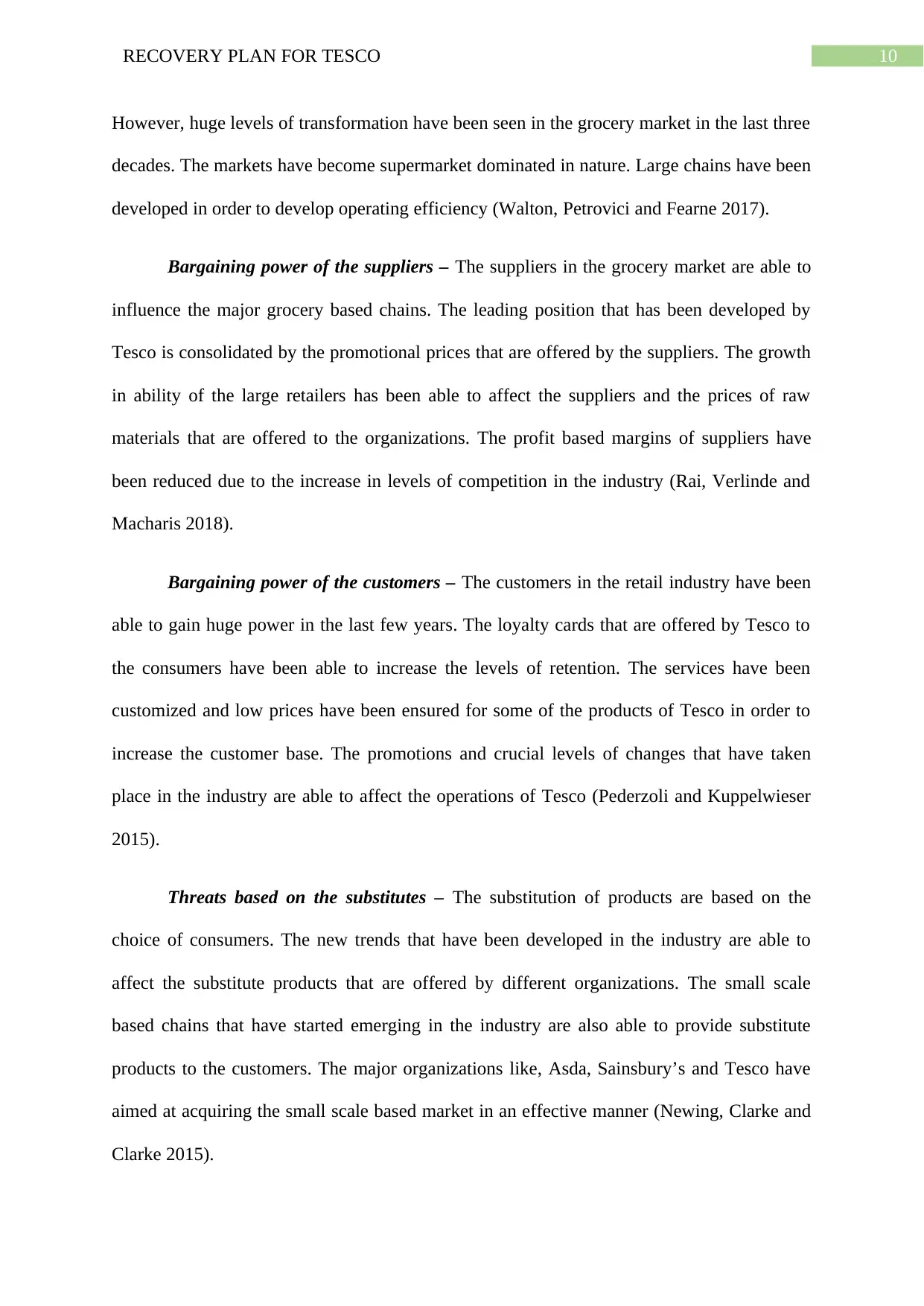
10RECOVERY PLAN FOR TESCO
However, huge levels of transformation have been seen in the grocery market in the last three
decades. The markets have become supermarket dominated in nature. Large chains have been
developed in order to develop operating efficiency (Walton, Petrovici and Fearne 2017).
Bargaining power of the suppliers – The suppliers in the grocery market are able to
influence the major grocery based chains. The leading position that has been developed by
Tesco is consolidated by the promotional prices that are offered by the suppliers. The growth
in ability of the large retailers has been able to affect the suppliers and the prices of raw
materials that are offered to the organizations. The profit based margins of suppliers have
been reduced due to the increase in levels of competition in the industry (Rai, Verlinde and
Macharis 2018).
Bargaining power of the customers – The customers in the retail industry have been
able to gain huge power in the last few years. The loyalty cards that are offered by Tesco to
the consumers have been able to increase the levels of retention. The services have been
customized and low prices have been ensured for some of the products of Tesco in order to
increase the customer base. The promotions and crucial levels of changes that have taken
place in the industry are able to affect the operations of Tesco (Pederzoli and Kuppelwieser
2015).
Threats based on the substitutes – The substitution of products are based on the
choice of consumers. The new trends that have been developed in the industry are able to
affect the substitute products that are offered by different organizations. The small scale
based chains that have started emerging in the industry are also able to provide substitute
products to the customers. The major organizations like, Asda, Sainsbury’s and Tesco have
aimed at acquiring the small scale based market in an effective manner (Newing, Clarke and
Clarke 2015).
However, huge levels of transformation have been seen in the grocery market in the last three
decades. The markets have become supermarket dominated in nature. Large chains have been
developed in order to develop operating efficiency (Walton, Petrovici and Fearne 2017).
Bargaining power of the suppliers – The suppliers in the grocery market are able to
influence the major grocery based chains. The leading position that has been developed by
Tesco is consolidated by the promotional prices that are offered by the suppliers. The growth
in ability of the large retailers has been able to affect the suppliers and the prices of raw
materials that are offered to the organizations. The profit based margins of suppliers have
been reduced due to the increase in levels of competition in the industry (Rai, Verlinde and
Macharis 2018).
Bargaining power of the customers – The customers in the retail industry have been
able to gain huge power in the last few years. The loyalty cards that are offered by Tesco to
the consumers have been able to increase the levels of retention. The services have been
customized and low prices have been ensured for some of the products of Tesco in order to
increase the customer base. The promotions and crucial levels of changes that have taken
place in the industry are able to affect the operations of Tesco (Pederzoli and Kuppelwieser
2015).
Threats based on the substitutes – The substitution of products are based on the
choice of consumers. The new trends that have been developed in the industry are able to
affect the substitute products that are offered by different organizations. The small scale
based chains that have started emerging in the industry are also able to provide substitute
products to the customers. The major organizations like, Asda, Sainsbury’s and Tesco have
aimed at acquiring the small scale based market in an effective manner (Newing, Clarke and
Clarke 2015).
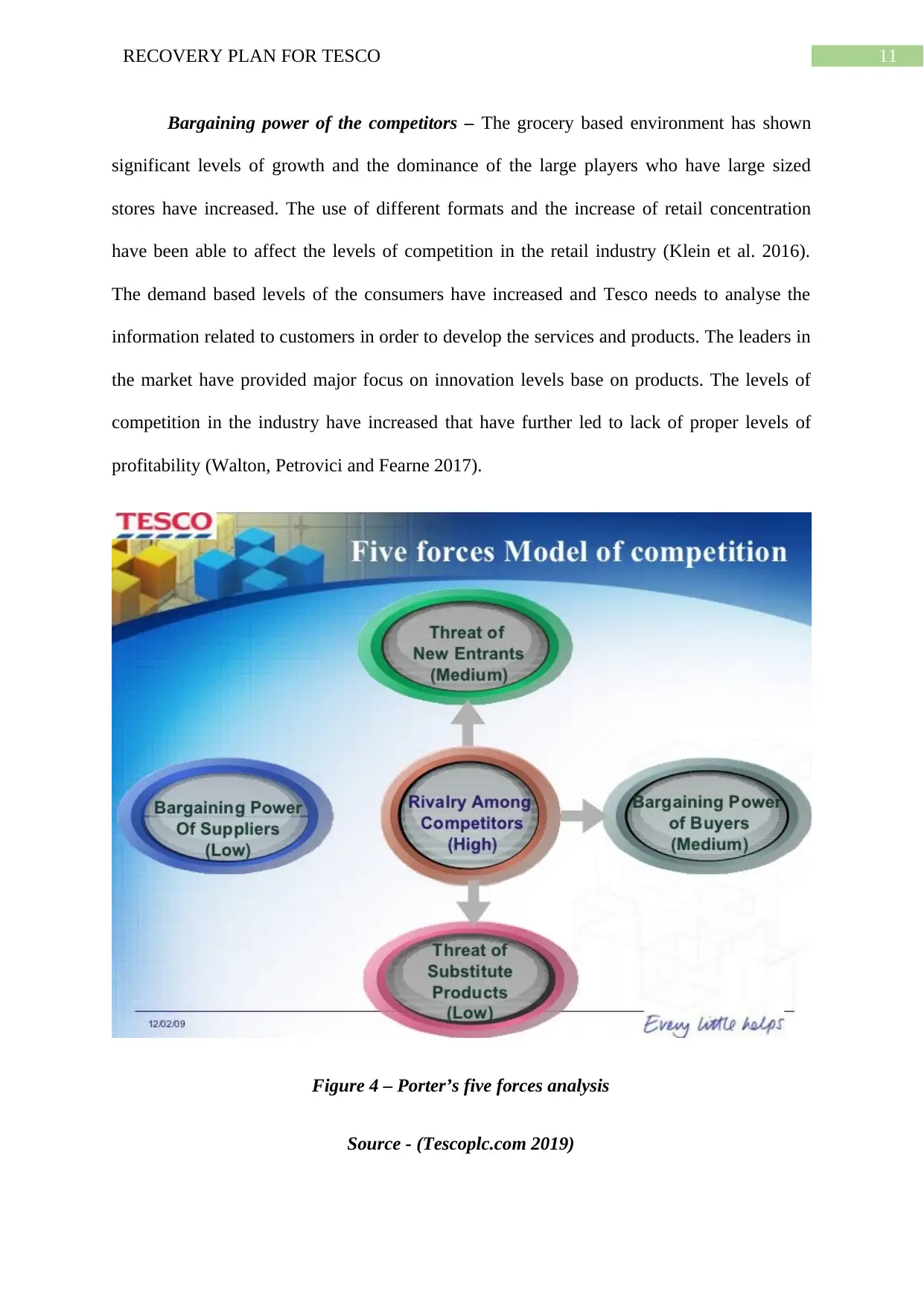
11RECOVERY PLAN FOR TESCO
Bargaining power of the competitors – The grocery based environment has shown
significant levels of growth and the dominance of the large players who have large sized
stores have increased. The use of different formats and the increase of retail concentration
have been able to affect the levels of competition in the retail industry (Klein et al. 2016).
The demand based levels of the consumers have increased and Tesco needs to analyse the
information related to customers in order to develop the services and products. The leaders in
the market have provided major focus on innovation levels base on products. The levels of
competition in the industry have increased that have further led to lack of proper levels of
profitability (Walton, Petrovici and Fearne 2017).
Figure 4 – Porter’s five forces analysis
Source - (Tescoplc.com 2019)
Bargaining power of the competitors – The grocery based environment has shown
significant levels of growth and the dominance of the large players who have large sized
stores have increased. The use of different formats and the increase of retail concentration
have been able to affect the levels of competition in the retail industry (Klein et al. 2016).
The demand based levels of the consumers have increased and Tesco needs to analyse the
information related to customers in order to develop the services and products. The leaders in
the market have provided major focus on innovation levels base on products. The levels of
competition in the industry have increased that have further led to lack of proper levels of
profitability (Walton, Petrovici and Fearne 2017).
Figure 4 – Porter’s five forces analysis
Source - (Tescoplc.com 2019)
⊘ This is a preview!⊘
Do you want full access?
Subscribe today to unlock all pages.

Trusted by 1+ million students worldwide
1 out of 18
Related Documents
Your All-in-One AI-Powered Toolkit for Academic Success.
+13062052269
info@desklib.com
Available 24*7 on WhatsApp / Email
![[object Object]](/_next/static/media/star-bottom.7253800d.svg)
Unlock your academic potential
Copyright © 2020–2025 A2Z Services. All Rights Reserved. Developed and managed by ZUCOL.





